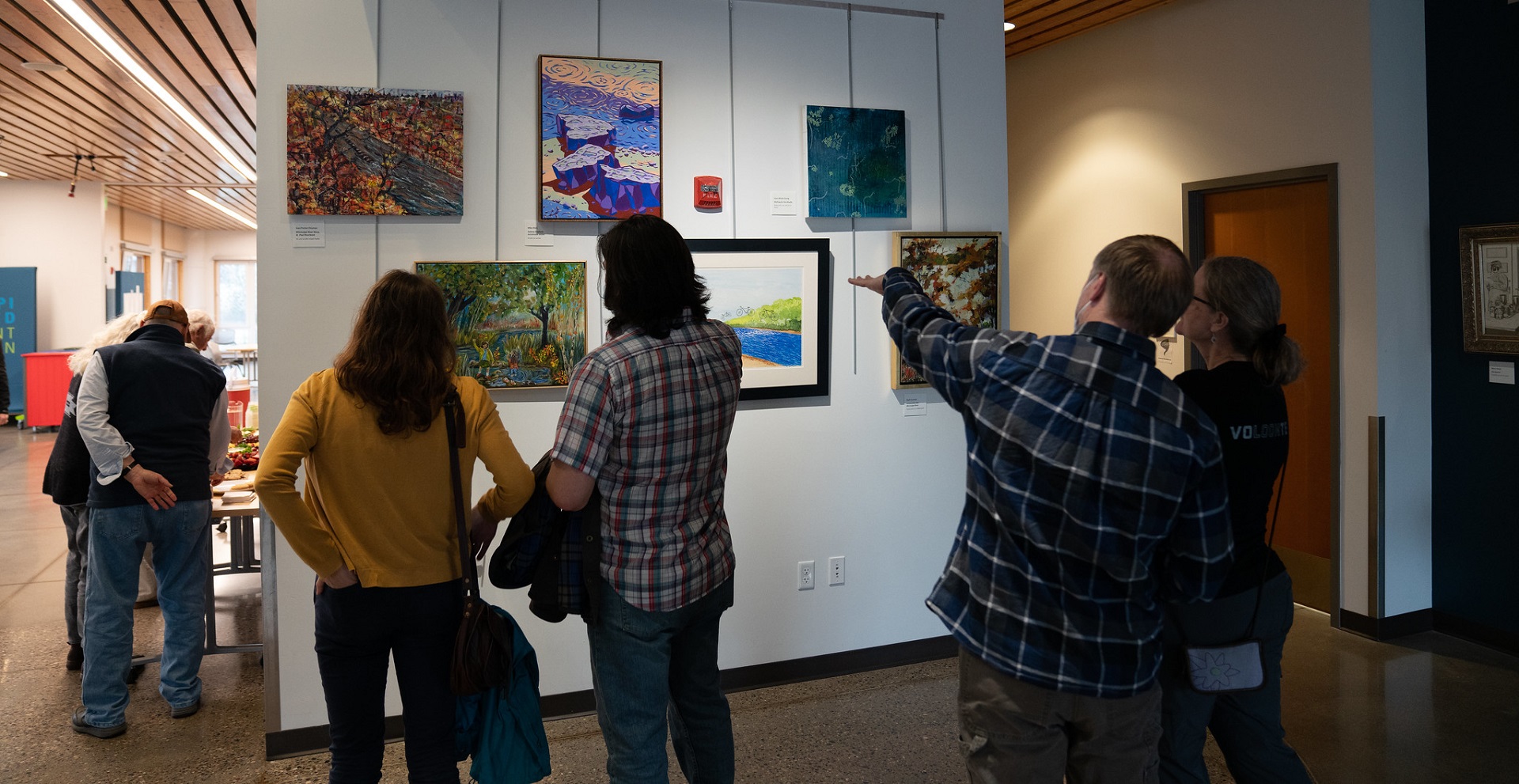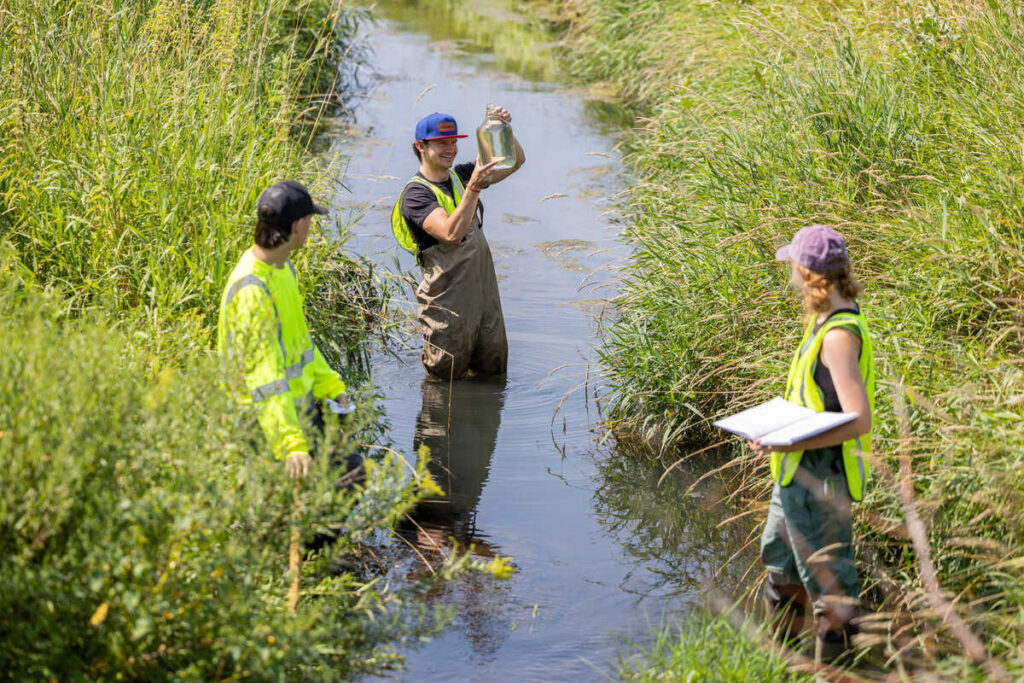Lining the gallery walls of the Mississippi Watershed Management Organization’s Stormwater Learning Center are stories about the Mississippi River translated into art.
The exhibit is a culmination of a multiyear collaborative project with the University of St. Thomas Sustainable Communities Partnership (SCP), the Mississippi Watershed Management Organization (MWMO), and the Natural Heritage Project (NHP).
The roots of the exhibit began in fall 2019 when the MWMO partnered with SCP to learn more about why the river is important to people in the Mississippi River watershed. Abby Moore, MWMO training and community learning specialist, explained, “understanding this helps us work better with communities across the watershed to engage them in stewardship of the river.”
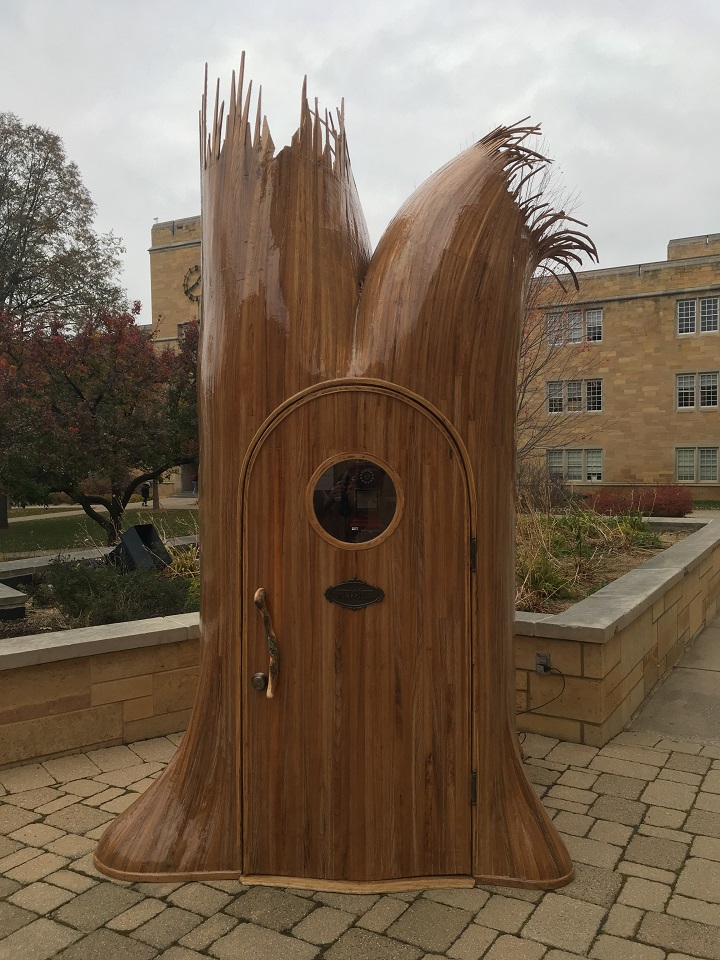
Students in Society and Sustainability (ENVR 212, fall 2019), taught by SCP Director Dr. Maria Dahmus, collaborated with the MWMO to explore this question – through a unique approach. Dahmus teamed up with Jessica Turtle, founder of NHP, to collect people’s river stories through NHP’s Elm Tree Story Booth, a 10-foot, hand built elm-shaped tree phone booth.
The instructions: Step inside the booth, pick up the phone, and share your story of the Mississippi River.
The Elm Tree Story Booth traveled to different neighborhoods to collect stories from diverse voices, including the University of St. Thomas. Amy Clark, one of the artists who participated in the exhibit, recalls seeing the Elm Tree Story Booth around the Twin Cities: “I would run across the story tree at various locations from time to time in the city and the joy never faded watching the thrill people received when they walked into the tree and recorded their stories. The participants became children again, delighting in the multi-sensorial experience.”
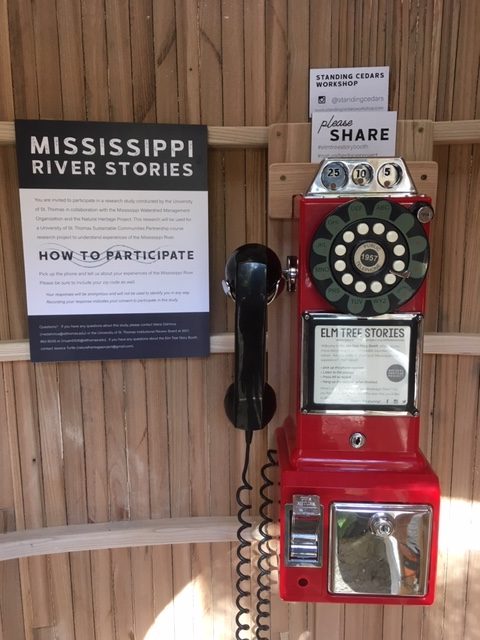
After collecting stories through the Elm Tree Story Booth, Dahmus’ students transcribed the stories and analyzed the data to identify patterns and themes in people’s stories.
Translating research into art
Then the translation of research into art began.
Inspired by the transformative impacts of efforts that connect art and sustainability, Dahmus started the SCP Arts program to integrate arts-based engagement with SCP projects. The goal: Students collaborate with local artists to translate their SCP project research into art. This interaction of research and art challenges students to think about their research more deeply as they explore how to translate their findings into art, and the artwork brings to life community-identified sustainability goals for people of all ages.
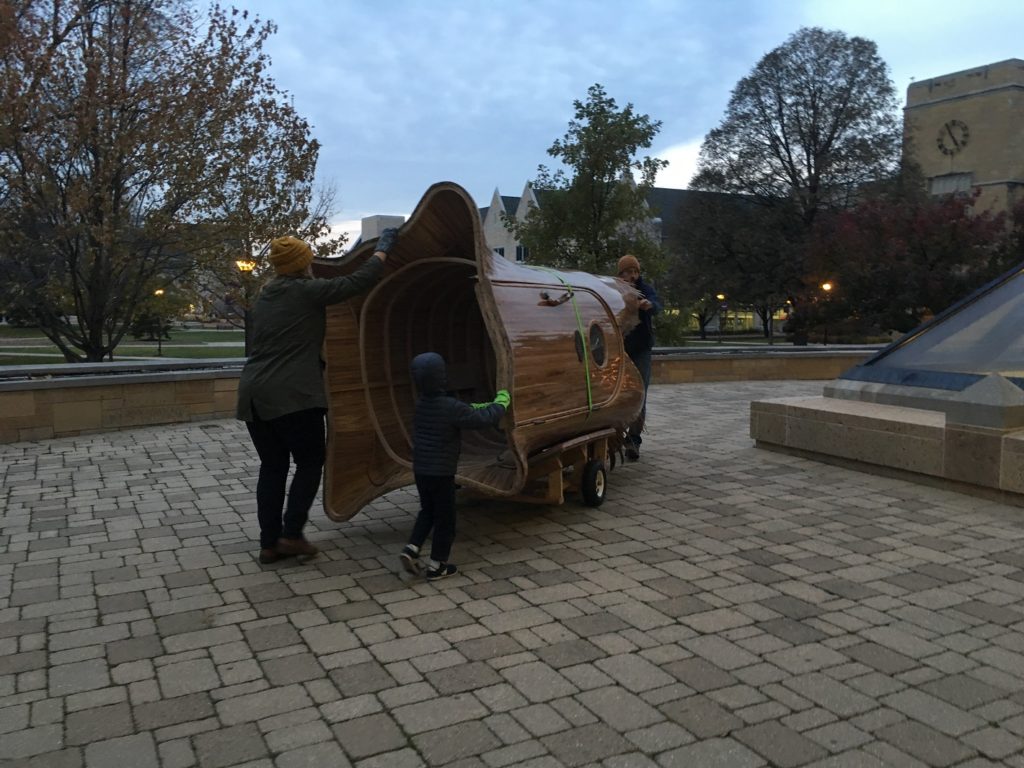
Through an iterative process of conversation and revision, students worked with SCP Artist-in-Residence Sarah Nelson to translate themes they found in their research into visual art, drawn by Nelson.
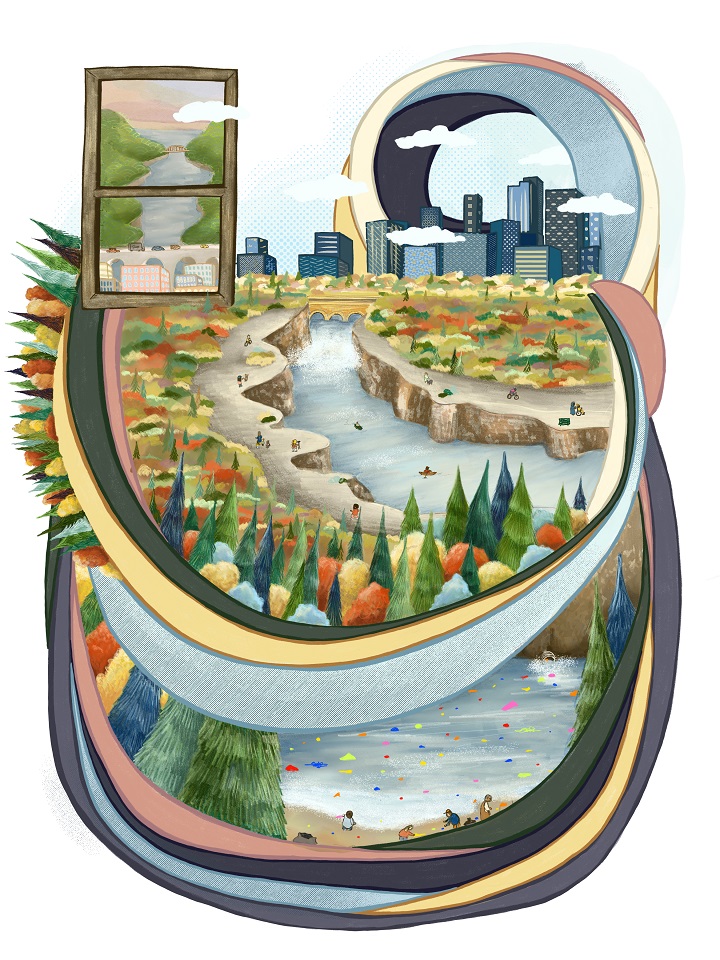
ENVR 212 student Rachel Schauer shared that one of her favorite parts of the class was the SCP project. “This experience showed me that using art to represent stories and raise awareness about local environmental issues is a great way to communicate research findings to a broader audience,” Schauer said.
Call to artists
Project partners also issued a call to artists to participate in the “Mississippi River Stories” art exhibit. The call: Create a work of visual art, inspired by a community member’s river story. Partners selected 15 artists from among the applicants and paired each artist with a different river story to bring to life.
For artists, receiving a community members’ river story to inspire their creation of artwork was a meaningful experience and impacted the artists in various ways.
For Mark Cosimini, the exhibit “offered the artist a chance to tell a very human story through their art. Adding the story to the visual experience created a work of art greater than each individual part. It’s so good to see the University of St. Thomas, through its partnerships with the community, incorporate the arts into the educational experience.”
Some of the stories were very personal to the artists. MaryBeth Garrigan received a story about the day the I-35W bridge collapsed. “I remember that day and I currently ride school buses with special needs students in the St. Paul School District, so I tried to reflect the positivity that the storyteller conveyed in his story. The painting’s title, “The Bus Grew Wings,” is the message the bus driver signed on the bus’s back door, 10 years after the collapse, was the positive inspiration for me. This Mississippi story reminds me how we as a community need gratitude for meaning in our lives.”
Other stories beckoned the artist to explore the banks of the Mississippi to inspire their pieces. Kristin Maija Peterson described her process: “I was given a story from a first-year student attending the University of St. Thomas. He spoke about his first encounter with the Mississippi River, how it felt, and what he observed, and I knew I wanted to retrace his steps to simulate what he experienced.” Similarly, Barbara Roger Bridges, a social practice artist, searched for the place described in the story to inspire her work: “When I received my story, it described 100 steps which descended to the riverbed. I found those steps and a magic walking path along the flood plains.”
Beyond the exhibit
The impact of students’ research and the artists’ pieces move beyond the walls of the exhibit. The project is informing the MWMO’s public outreach programs and also inspires engagement with the river. Dahmus noted that “arts-based engagement creates a unique and welcoming entry point for people of different backgrounds to explore sustainability.”
This is why artists like Jason Arney-O’Neil shared his work in the exhibit. Arney-O’Neil “felt great pleasure being a part of a beautiful collection of stories and talented artists. Sharing stories about our appreciation for the river gives me hope that we can come together and raise awareness and help repair this critical ecosystem.”
For viewers and artists alike, the exhibit inspired reflection and appreciation for our interaction with the river and those who work to keep it healthy. “The river means so much to all of us,” artist Sharon DeMark said. “I’m grateful for all the river’s stewards who work hard in different ways to keep it healthy and accessible.”
For the MWMO, “the SCP program has been a win-win for us and our partners, and it’s always exciting to see where each new project takes us.”
Dahmus loved seeing all of this come together and come to life, the multiple and mutual benefits for students, partners, and the community through collaboration. This is part of the broader mission of SCP: for students to develop real-world, creative problem-solving skills, make connections in the Twin Cities community, and gain confidence to be listeners, leaders, and collaborators in sustainability in their future career paths, all while advancing community sustainability goals.
“This class gave me the opportunity to learn more about water quality and environmental issues in urban watersheds and inspired me to learn more about the watershed I live in,” Schauer said. “After taking this class, I researched the issues in my local watershed and started volunteering with a citizen science program through the watershed district.”
And the exhibit also inspires viewers to visit the river. As Peterson noted, “we feel so much better sitting at the river’s edge.”
“Mississippi River Stories” exhibit will be open until June 6 at the Mississippi Watershed Management Organization, 2522 Marshall St. NE, Minneapolis. Visit the virtual gallery to view the artwork and read the river stories.
Participating artists:
Laura Ahola-Young, Jason Arney-O’Neil, Barbara Rogers Bridges, Amy Clark, Mark Cosimini, Wynn Davis, Sharon DeMark, MaryBeth Garrigan, Jerry Allen Gilmore, Stefanie Kiihn, Mike Klein, Kristin Maija Peterson, Joan Porter-Einsman, Ric Rosow and Beatriz Sanchez
